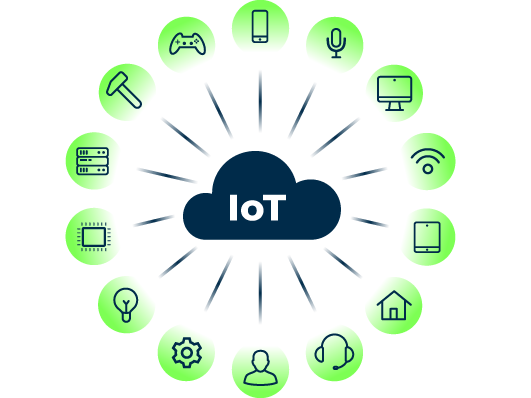
The Internet of Things (IoT) refers to the network of connected devices that communicate with each other and the cloud. Thanks to advances in technology, including affordable computer chips and high-speed internet, billions of devices—such as toothbrushes, vacuum cleaners, cars, and machinery—are now online. These smart devices use sensors to collect data and respond to user interactions intelligently.
What is IoT?
The Internet of Things, or IoT, is a system of physical objects embedded with sensors and software, allowing them to connect to the internet and exchange data. This network of smart devices interacts with the cloud and with each other, creating a more responsive and efficient environment.
Initially, adding computing capabilities to everyday objects was slow due to bulky and expensive chips. Early on, RFID tags were used to track valuable equipment. However, as technology improved, these chips became smaller, faster, and more affordable, enabling a broader range of devices to connect.
Today, integrating computing power into everyday objects is more cost-effective. For example, adding Alexa voice capabilities to a light switch is now possible. This has led to a surge in IoT devices in homes, businesses, and offices, forming the basis of the Internet of Things.
How Does IoT Work?
An IoT system operates through three main components:
- Smart Devices:
- What They Do: These are objects like TVs, security cameras, or fitness trackers equipped with computing capabilities. They gather data from their surroundings or user interactions and send it over the internet.
- IoT Application:
- What It Does: This software or service processes data from various IoT devices. Using machine learning or artificial intelligence (AI), it analyzes this data to make decisions, which are then communicated back to the devices to guide their actions.
- User Interface:
- What It Does: Provides a way for users to manage and control IoT devices. This could be through a mobile app, a web dashboard, or other interfaces.
Examples of IoT Devices
Here are some practical examples of how IoT devices are used today:
- Connected Cars:
- How They Work: Vehicles use smart dashcams, infotainment systems, and connected gateways to monitor aspects like acceleration, braking, and fuel levels.
- Uses:
- Monitoring rental car fleets to improve fuel efficiency.
- Tracking driving behavior for safety.
- Notifying contacts in case of an accident.
- Predicting and preventing maintenance needs.
- Connected Homes:
- How They Work: Smart home devices improve comfort and efficiency by automating tasks and enhancing security.
- Uses:
- Smart Outlets: Track and control electricity use.
- Smart Thermostats: Adjust home temperature.
- Hydroponic Systems: Manage indoor gardens.
- Smart Smoke Detectors: Detect smoke and send alerts.
- Home Security Systems: Include smart locks, cameras, and leak detectors.
- Smart Cities:
- How They Work: IoT technology enhances urban planning and infrastructure management.
- Uses:
- Air Quality Monitoring: Measures pollution levels.
- Smart Lighting: Reduces energy consumption.
- Infrastructure Maintenance: Detects issues with roads and bridges.
- Parking Management: Optimizes parking space usage.
- Smart Buildings:
- How They Work: Buildings use IoT devices to improve efficiency.
- Uses:
- Energy Management: Reduces power usage.
- Maintenance: Lowers costs and improves upkeep.
- Space Utilization: Optimizes the use of workspaces.
What is Industrial IoT (IIoT)?
Industrial IoT (IIoT) applies smart devices to industries like manufacturing, retail, and healthcare to create efficiencies. IIoT devices offer real-time data on various business processes, helping to:
- Manufacturing: Use predictive maintenance to minimize downtime and improve worker safety.
- Automobile Industry: Employ sensors for diagnostics and automated part ordering.
- Logistics and Transport: Enhance supply chain management with real-time tracking and optimized fuel usage.
- Retail: Innovate with robots for inventory management and automation in warehouses.
How IoT Can Improve Our Lives
IoT has the potential to transform daily life by automating tasks and making environments more responsive. For instance:
- Morning Routines: Your alarm clock could trigger the coffee maker and open blinds. Your fridge might order groceries automatically, and your oven could cook meals based on a preset menu.
- Scheduling and Navigation: Your smartwatch could manage your calendar while your connected car optimizes your route and refuels as needed.
Benefits of IoT for Businesses
IoT provides several advantages for businesses:
- Accelerate Innovation: Advanced analytics reveal new opportunities and enable targeted marketing.
- Data-Driven Insights: AI and machine learning predict future trends and enhance customer service.
- Enhanced Security: Continuous monitoring improves performance and safety, with automatic system updates.
- Scalable Solutions: IoT technologies can be customized to meet customer needs and manage inventory effectively.
Key IoT Technologies
Several technologies support IoT systems:
- Edge Computing: Increases computing power at the edge of the network, reducing latency and improving response times.
- Cloud Computing: Provides remote data storage and management, making information accessible across the network.
- Machine Learning: Processes data and makes real-time decisions based on algorithms deployed in the cloud or at the edge.
What is AWS IoT?
AWS IoT combines AI and IoT to enhance business outcomes. It offers services like:
- Security: Protects data through encryption and access controls.
- Scalability: Supports billions of devices and trillions of messages.
- Integration: Works with other AWS services to create comprehensive IoT solutions.
In summary
The Internet of Things connects devices and systems in ways that improve efficiency, convenience, and innovation. From smart homes and cities to industrial applications, IoT is reshaping our world by making everyday life more automated and responsive.


